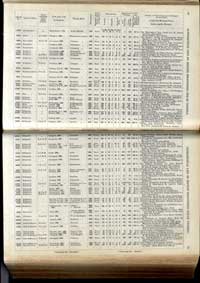Home Trade Vessels
The owners of ships involved in the home trade were numerous in Newcastle because of the massive amounts of coal mined in the region, and then shipped around Britain and the near continent. Coal cargoes were shipped much longer distances too, but since the Brio and the vessels short-distance runs are of interest here, this discussion concerns the company which owned the vessel.
R.S. Gardiner and J. Reay were neither the largest, nor the smallest, company that specialized in the home trade in coal from their headquarters in Newcastle. In 1908, this limited company had a fleet of ten colliers. They were steel-hulled, screw propelled vessels, mostly between 600 and 900 tons, and powered with engines in the range of 90-120 horse power.
The fleet was kept up to date; the Brio, built in 1891, for the company by a Scottish shipbuilder, was one of their oldest. In 1908, they were trading successfully in a depressed market. Cram found regular employment with the company, moving between the Primo, Alto, and Brio during the period for which we have traced his voyages in the Agreements.
 The MHA has digitalized many copies of an annual publication of the Board of Trade Merchant Navy List (MNL) and made them accessible from the MHA main website. All British Empire vessels over fifteen tons are recorded there in the publications for years when they were officially registered. The Brio's entry in the 1907 MNL is reproduced here.
The MHA has digitalized many copies of an annual publication of the Board of Trade Merchant Navy List (MNL) and made them accessible from the MHA main website. All British Empire vessels over fifteen tons are recorded there in the publications for years when they were officially registered. The Brio's entry in the 1907 MNL is reproduced here.
The MNL contains a wealth of information in a one-line entry, so, in addition to the official number we learn how the Brio was recognized for telegraphy purposes (its International Code signal); that its port of registry is Newcastle, where it was first registered in 1891; that Brio was constructed in a shipyard in Campbeltown in Scotland and launched in 1891; it was steel hulled with dimensions (in feet) of 225 x 33 x 16.4; it measured 700 net tons and 1108 gross and carried engines of 98 horse power, using screw propeller propulsion.
A Note on Finding Official Numbers
To find the Agreements of Cram's ships, researchers had to locate their official numbers: the MHA documents are filed by this number. Watching the video on this site "Welcome to the Maritime History Archive" will explain why: the following explains how you find a number and then how you can check for what documents have survived and now constitute archival holdings.
In the MNL the vessel's number is first (97966) and that is key to next stage of our research. Using this number we can refer to the index of Crew Agreements on the MHA main website and establish whether the MHA holds the ship's Agreements, and if so for which years. The MHA index tells us that the archive holds at least one Agreement for the Brio for each of the years 1891, 1892, 1893, 1894, 1897, 1899, 1900, 1902, 1903, 1904, 1906, 1908, 1909, and 1910.
